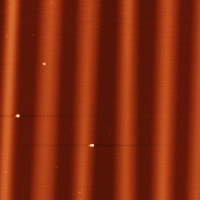This effect is seen as broad "stripes" in your AFM images, running along the slow scan direction. They are caused by constructive interference between the reflection of the laser from the tip, and the reflection from the sample. See the example below.

In the example above, the near-vertical stripe-like oscillations are cause by laser interference.
How to avoid it.
Sometimes this effect is really hard to avoid. It is more noticable on flat samples, and large (<3 micron) images, and is worse with small, less reflective cantilevers, and of course with more reflective samples. It's easy to recognise because usually the stripes will be spaced at double the wavelength of the laser used(i.e. it's usually ca 1.3 microns). The best way to avoid this artifact is to re-align the laser, to ensure as little as possible spreads over the edge of the cantilever. Note: Many newer AFMs use a low-cofenerence laser, and so are much less prone to this problem.



